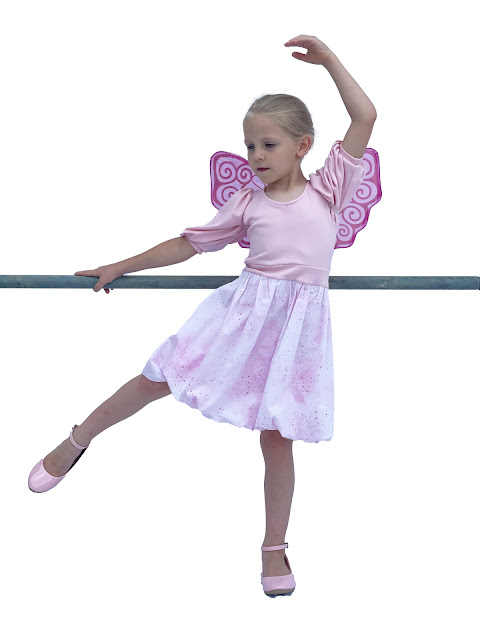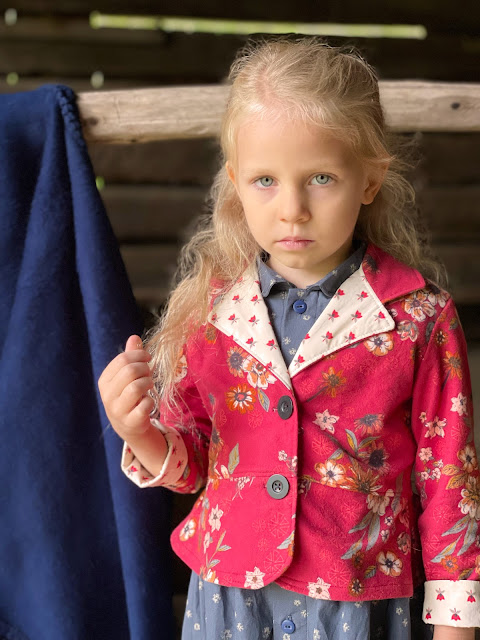As part of our Lagoon week activities, roday we have a great tutorial for you! This week we're shining the spotlight on the Lagoon Top, Dress & Skirt pattern.
Be sure to grab the Lagoon pattern at 40% off with the code only found in our Newsletter! (Sign Up Below)
Today we are answering one of the most commonly requested questions, "Can I use woven fabric for a knit pattern?" Or to put it another way, "Can I use non-stretch fabric for a pattern drafted for stretch fabric?"
Our answer: Sometimes! And with some very specific modifications.
1. Look at the finished measurements
First of all, you need to start with an appropriate pattern. We've made a list of more suitable patterns for this below. When you're looking at the finished measurements chart, if you see that a garment has negative ease (this means it's smaller than your child's measurements - usually found in swimwear, leggings, fitted tees and so on) this is really not a suitable pattern for using woven fabric.
2. Make part of the pattern from woven fabric
If you make only the front of the bodice from woven fabric, but the back and sleeves from knit or stretch fabric, you're good to go! The knit/stretch fabrics will stretch, and you can still use the pretty woven fabric. You can see how Jenny did this with the Lagoon pattern in the dress above. She used (non-stretch) fabric for the bodice front, and stretch fabric for the bodice back, waistband and skirt.
3. Gathers = You're good!
If the knit pattern is gathered in any part, you can use woven fabric for that part. In the photo above, you can see where Audrey used woven fabric for the bubble overlay on the Lagoon Dress and knit fabric for every where else.
4. Reduce the number of layers
The more layers there are, the tighter it will be. For example, if the garment is designed to be fully lined, you may be able to eliminate the lining and use non stretch fabrics.
4. Usually size up or size up in tight areasWhen you were looking at the finished measurements chart, you may have noticed your child's measurements were larger than the finished measurements. Or some of them were. In those areas, be sure to go up to the next size. In the photo above, Audrey used flannel fabric on the Base Blazer, and the only area she wished she'd sized up is the arms as the roll up cuff was very hard to roll up.
5. Add extra width/height as neededSome knit patterns are designed for knit fabric with 2 way stretch. This means the fabric stretches only either vertically or horizontally. These are better candidates for using woven fabrics on some sections, as the pattern is already designed for fabrics with less stretch. Other patterns call for fabric with 4 way stretch, which means the fabric stretches BOTH horizontally and vertically. These will require more sizing up adjustments, usually around the body, which is where most knit patterns are designed to stretch. Another area to consider is the underarm point, which will probably need to be dropped for woven fabric, as knit garments are usually designed to hug the underarm area.
6. Make a muslin!!!!This should probably be point number one! But after making all the adjustments to the pattern that you think might be needed, you DEFINITELY need to make a muslin or practice garment before you sew the real thing with that special woven fabric you just HAVE to use!
7. Finish your seamsKnit pattern instructions don't always include options for finishing the raw edges of your seams. But since woven and non-stretch fabrics will fray, you should use a zig zag stitch or serger to neaten up the insides of your garment. Delicate fabrics like Organza, chiffon or double gauze may even need French seams, since those fabrics are especially delicate and prone to fraying.
8. Use gathering stitches for places that would be stretched to fit.If the garment is supposed to be stretched or eased to fit while sewing (for example an armscye or waist) you will need to add gathering stitches to the larger piece to make it fit to the smaller piece.
Knit patterns more suitable for using woven fabrics on some pieces:Don't take this list as our blanket approval that any of these patterns can be used for using woven fabrics! These are just some suggestions of patterns that are easier to modify for wovens from out pattern shop. Use our tips above for a successful outcome!
Patterns already designed for knit AND/OR woven fabric:
Get in on the exclusive sales!
* indicates required







No comments :
Post a Comment
Note: Only a member of this blog may post a comment.